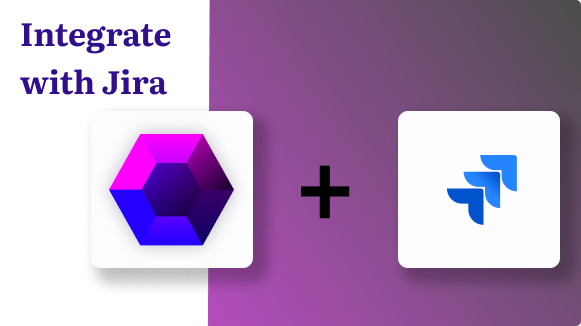Jira Integration
If you’re already using both Jira and Chisel, Chisel’s Jira integration is the perfect tool to ensure that work items are synchronized between the two platforms.
Requirements:
To get started, you will need the following:
- Chisel’s premium account with Admin maker rights
- A Jira account and a project
Note: A Chisel account with contributor access can’t proceed with any integration process. Learn more about the Chisel user roles.
Authorizing Jira Integration With OAuth2
When setting up an integration between Chisel and Jira, the first step is to authorize the integration between both the platforms with OAuth2.
Follow the steps below to authorize the Jira integration with OAuth2.
- Click on ‘Integrations’ under the workspace on the left navigation bar.
- Once you click on ‘Integrations,’ you will see a screen that shows you all the integrations you have set up(active integrations) and other integrations you can set up.

- Next, click on the connect button next to Jira.
- If you are already logged into Jira, you will be brought to a screen where you can see all the authorization-related access and Chisel requests for the Jira Integration.
- Scroll down and kindly accept the authorization by clicking on the ‘Accept’ button.
Pro Tip: If you are not logged into Jira, kindly log in and follow the above step.
- Now you will be navigated back to your Chisel workspace, where you will configure the integration as per your requirements.
Standard Configurations
Now that you have authorized the integration, you will have to configure the integration.
Follow the below three steps for standard configuration.
Choose Jira Project
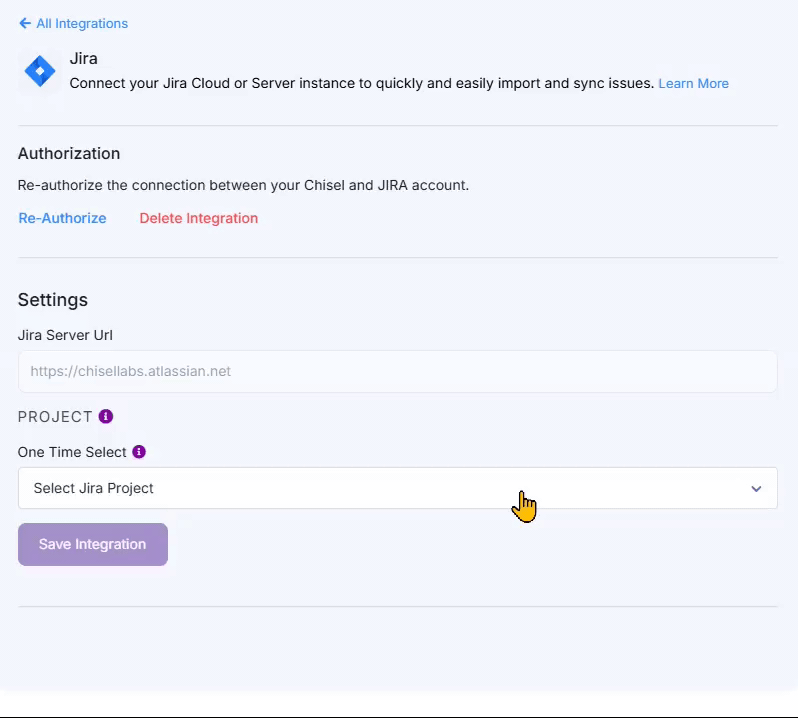
The first step for configuring the Jira integration is to choose the correct Jira project.
- Kindly choose the Jira project you want to integrate with Chisel and click on ‘Save Project.’
Two-way Sync
Two-way synchronization enables information to flow back and forth between Chisel and Jira.
Information like name, description, status, and timeline data when changed in Jira, would be reflected in your Chisel workspace and vice versa.
Note: One important thing to remember about the ‘two-way sync’ button is that all the relevant changes will be synchronized and updated only after you’ve enabled the button and ‘Saved the Integration.’ That means the changes you make after toggling the two-way sync button will be visible. However, the changes you made before the button was toggled will not get updated.
- To enable two-way sync, kindly enable the toggle below the 2-way Sync.
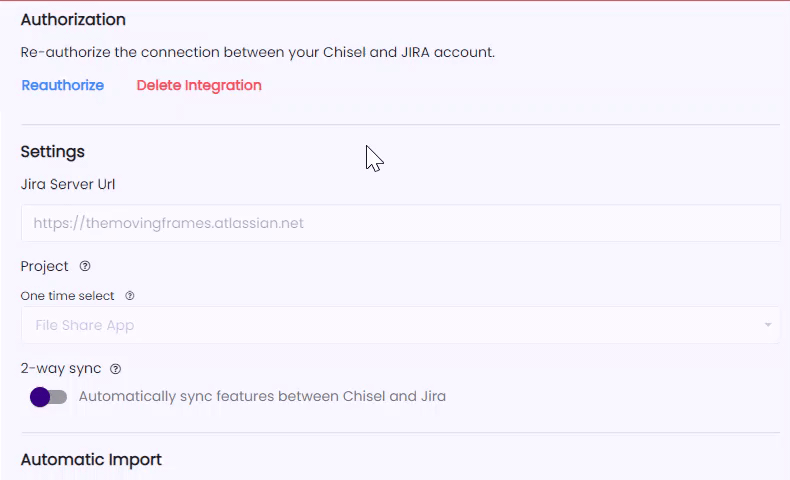
Automatic Import From Jira
Enabling Automatic Import from Jira would help you automatically import issues from Jira to your Chisel workspace.
- To enable the Automatic Import of features from Jira, kindly enable the toggle below the ‘Automatic Import.’
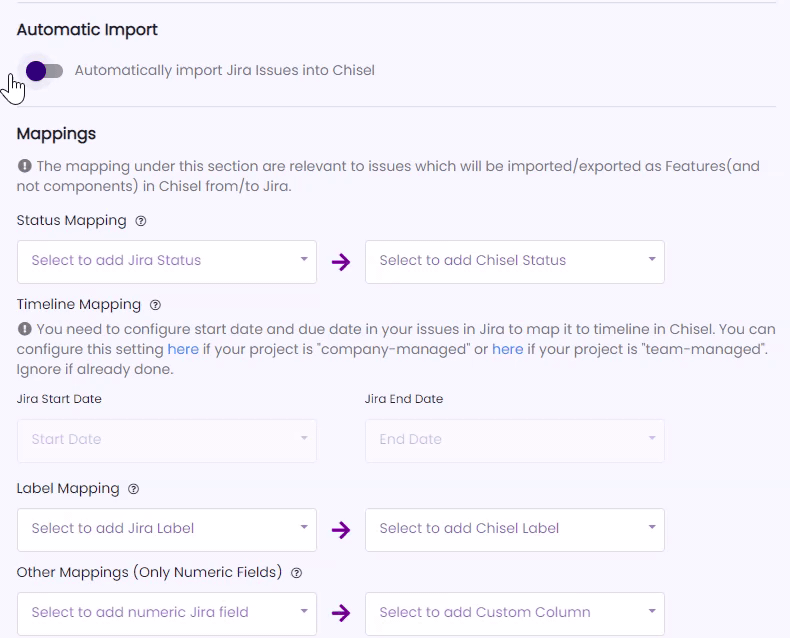
If you choose to enable automatic import, you will have to configure ‘Destination’ and ‘Issues types’ as mentioned below –
- Under ‘Choose Destination – Product,’ select the Product from your Chisel workspace where you want the imported components to be created.
- Under ‘Choose Destination – Component,’ select the Component from your Chisel workspace where you want the imported features to be created.
- Under ‘Choose Issue Type – Import as a Component,’ select the issue types (part of the Jira workspace) from the list which you want to be imported as Components in your Chisel workspace.
- Under ‘Choose Issue Type – Import as a Feature,’ Select the issue types (part of the Jira workspace) from the list which you want to be imported as Features in your Chisel workspace.
Jira – Chisel Mappings
The next step in the Jira integration is to map different entities between Jira and Chisel as nomenclature may differ between your Chisel workspace and Jira project.
Default Mappings
By default, the name, description, start date, and due date will be mapped automatically.
Status Mappings
- The status from the Jira project and kanban status from Chisel needs to be mapped to stay in sync with each other.
- For status mapping, you need to map every status from Jira with a kanban status in Chisel.
Label Mappings
The labels created in Chisel and Jira need to be mapped so that both stay in sync with each other.
- For label mapping, you need to map every label from Jira with a label in Chisel.
- After completing the above steps, kindly verify all the inputs you gave and click on Save Integration.
Custom Mapping
You can map custom columns(CC) and prioritization drivers(PD) in Chisel with custom fields in Jira so that they can be updated from anywhere and stay in sync.
Custom columns are handy numerical and categorical fields that allow you to add various additional information attached to the features in the roadmap.
- To map a custom column created in Chisel to a custom field in Jira, you need to create a custom field in Jira with a similar type.
- A ‘number’ type custom column needs to be mapped with a ‘number’ type custom field in Jira.
- While an ‘option’ type custom column needs to be mapped with a ‘dropdown’ type custom field in Jira.
- Each of the options needs to be mapped with a dropdown value for sync to work seamlessly.
Similarly, prioritization drivers can be of 3 types – Rating, Exponential, and T-shirt sizing.
Rating needs to be mapped with a ‘number’ type custom field in Jira.
Exponential and T-shirt sizing needs to be mapped with a ‘dropdown’ type custom field in Jira.
Release Mapping
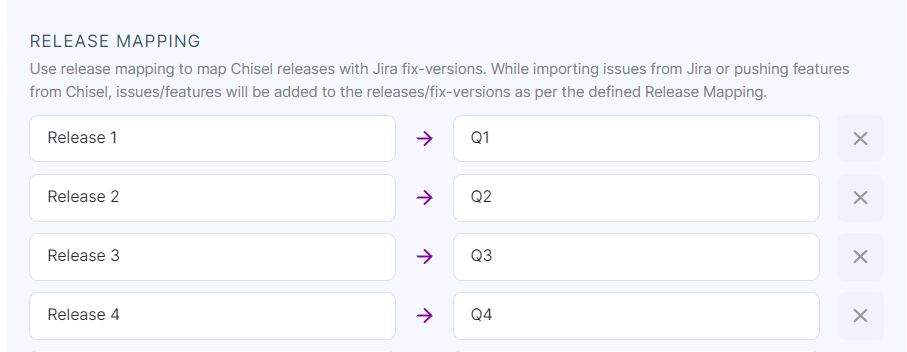
Release mapping is where you have to map Chisel releases with Jira fix versions. This release/fix version mapping will sync when you push/ import the features from Chisel and the issues from Jira.
- The Jira fix versions are on the left side, and the Chisel release mapping is on the right. Carefully select the mapping as per the requirement.
- A few things to remember when mapping:
- A feature can have multiple releases assigned.
- A sub-feature will have only a single release assigned
- When you select a release for a sub-feature, it will automatically assign the release to its corresponding feature as well.
One Time Import
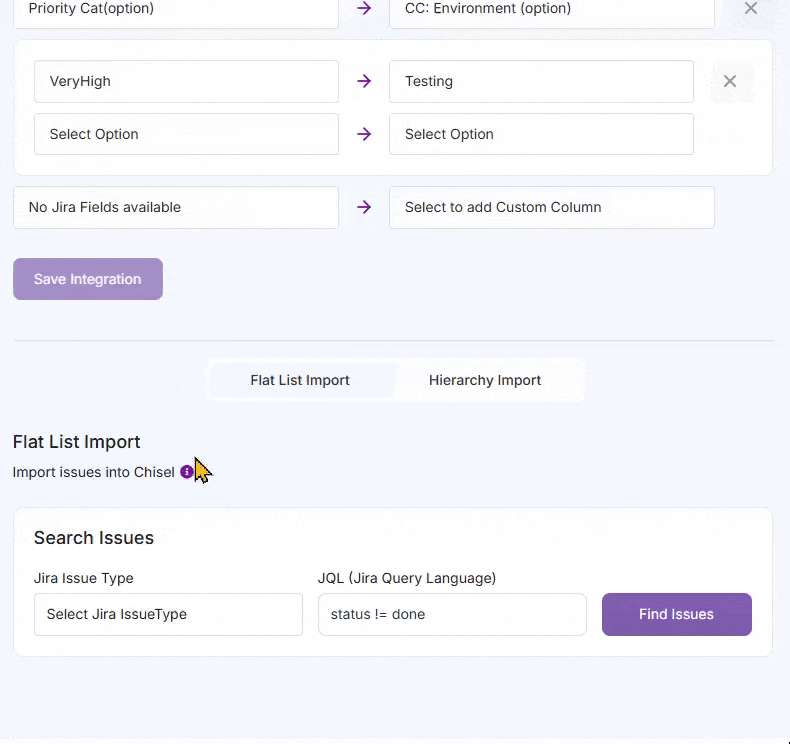
Apart from automatic import, Chisel also allows you to import the issues which are already in your Jira project to your Chisel workspace.
- Select the Issue Types which you want to import into the Chisel workspace
- Rewrite the JQL query in case required, and hit the ‘Find Issues’ button. The section below will show you all the issues present in your Jira project fulfilling the JQL query you put.
- Now you can choose to Import the issue types as a Feature or as a Component. You can toggle between Feature and Component as per your requirement.
Import as Feature
- If you choose to import it as Features, kindly select the Component from your Chisel workspace where you want the imported features to be created.
Import as Component
- If you choose to import it as Components, kindly select the Product from your Chisel workspace where you want the imported components to be created.

